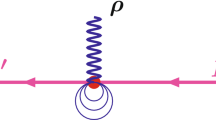Abstract
We present one example of the complete next-to-leading order potential of a \({{B}^{{( * )}}}\) – \({{\bar {B}}^{{( * )}}}\) system for the partial waves \({{J}^{{PC}}}\) = 0++, 1++, 1+–, 2++. The potential is ready to be used in a Lippmann-Schwinger equation. Then a fit to data for the exotic states Zb(10610) and Zb(10650) should reveal important information about the convergence of the chiral expansion for the given system.

Similar content being viewed by others
REFERENCES
S.-K. Choi et al., “Observation of a Narrow Charmoniumlike State in Exclusive B ± → K ±π+π− J/ψ Decays,” Phys. Rev. Lett. 91, 262001 (2003). https://doi.org/10.1103/PhysRevLett.91.262001
A. Bondar et al., “Observation of Two Charged Bottomoniumlike Resonances in ϒ(5S) Decays,” Phys. Rev. Lett. 108, 122001 (2012). https://doi.org/10.1103/PhysRevLett.108.122001
N. Brambilla, S. Eidelman, C. Hanhart, A. Nefediev, Cheng-Ping Shen, C. E. Thomas, A. Vairo, and Chang-Zheng Yuan, “The XYZ States: Experimental and Theoretical Status and Perspectives,” Phys. Rep. 873, 1 (2020). https://doi.org/10.1016/j.physrep.2020.05.001
A. E. Bondar, A. Garmash, A. I. Milstein, R. Mizuk, and M. B. Voloshin, “Heavy Quark Spin Structure in Z b Resonances,” Phys. Rev. D 84, 054010 (2011). arXiv: 1105.4473 [hep-ph]https://doi.org/10.1103/PhysRevD.84.054010
Q. Wang, V. Baru, A. A. Filin, C. Hanhart, A. V. Nefediev, and J.-L. Wynen, “The Line Shapes of the Z b(10610) and Z b(10650) in the Elastic and Inelastic Channels Revisited.” Phys. Rev. D 98, 074023 (2018). https://doi.org/10.1103/PhysRevD.98.074023
V. Baru, E. Epelbaum, A. A. Filin, C. Hanhart, A. V. Nefediev, and Q. Wang, “Spin Partners W bJ from the Line Shapes of the Z b(10610) and Z b(10650),” Phys. Rev. D 99, 094013 (2019). https://doi.org/10.1103/PhysRevD.99.094013
M. B. Voloshin, “Radiative transitions from Upsilon(5S) to Molecular Bottomonium,” Phys. Rev. D 84, 031502 (2011).https://doi.org/10.1103/PhysRevD.84.031502
T. Mehen and J. W. Powell, “Heavy Quark Symmetry Predictions for Weakly Bound B-Meson Molecules,” Phys. Rev. D 84, 114013 (2011). https://doi.org/10.1103/PhysRevD.84.114013
A. E. Bondar, R. V. Mizuk, and M. B. Voloshin, “Bottomonium-Like States: Physics Case for Energy Scan Above the B¯B Threshold at Belle-II,” Mod. Phys. Lett. A 32, 1750025 (2017). https://doi.org/10.1142/S0217732317500250
V. Baru, E. Epelbaum, A. A. Filin, C. Hanhart, and A. V. Nefediev, “Spin Partners of the Z b(10610) and Z b(10650) Revisited,” JHEP 06, 158 (2017). https://doi.org/10.1007/JHEP06(2017)158
J. Gasser and H. Leutwyler, “Chiral Perturbation Theory to One Loop,” Annals Phys. 158, 142 (1984). https://doi.org/10.1016/0003-4916(84)90242-2
M. B. Wise, “Chiral Perturbation Theory for Hadrons Containing a Heavy Quark,” Phys. Rev. D 45, R2188 (1992). https://doi.org/10.1103/PhysRevD.45.R2188
A. V. Manohar and M. B. Wise, “Heavy Quark Physics,” in Cambridge Monographs on Particle Physics, Nuclear Physics and Cosmology (Univ. Press, Cambridge, 2000), p. 60f. https://doi.org/10.1017/CBO9780511529351.006
M. P. Valderrama, “Power Counting and Perturbative One Pion Exchange in Heavy Meson Molecules,” Phys. Rev. D 85, 114037 (2012). The signs of D2, E2 change due to opposite C-parity, p. 16. https://doi.org/10.1103/physrevd.85.114037
ACKNOWLEDGMENTS
We acknowledge support by the National Natural Science Foundation of China (NSFC) and Deutsche Forschungsgemeinschaft through funds provided to the Sino-German Collaborative Research Center “Symmetries and the Emergence of Structure in QCD” (NSFC grant no. 11621131001, DFG grant no. TR110).
Author information
Authors and Affiliations
Corresponding authors
About this article
Cite this article
Krug, S.L., Hanhart, C. The Complete Next-to-Leading Order Potential of \({{{\mathbf{B}}}^{{( * )}}}{{{\mathbf{\bar {B}}}}^{{( * )}}} \to {{{\mathbf{B}}}^{{( * )}}}{{{\mathbf{\bar {B}}}}^{{( * )}}}\) . Bull. Lebedev Phys. Inst. 47, 334–338 (2020). https://doi.org/10.3103/S1068335620110032
Received:
Revised:
Accepted:
Published:
Issue Date:
DOI: https://doi.org/10.3103/S1068335620110032




